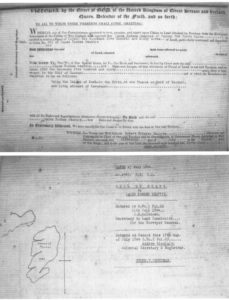SETTLEMENT BEGINS
Located in the inner Hauraki Gulf Kawau Island has a long history associated with human activity. Kawau has been used as a base for centuries during fishing expeditions in the surrounding waters. Missionary Samuel Marsden called at Kawau in 1820 on his way to Coromandel to observe loading of kauri spars, and recorded that the Island was unoccupied at that time.
The present settlement originated prior to the signing of the Treat of Waitangi (Tiriti o Waitangi) in January 1840 when Mr W.T. Fairburn arranged with Maori owners to purchase the island of Kawau on behalf of Mr Henry Tayler. An arrangement that led to the sale of Kawau Island to Mr James Forbes Beattie, who was acting on behalf of the North British Australian Loan and Investment Company. The purchase document as shown below shows that the Island was bought for a cost 197 pounds nine shillings.There was a delay in confirmation of the purchase due to a proclamation issued by Sir George Gipps, then Governor of New South Wales just three days after Mr Fairburn made the arrangements, but a Crown Grant in favour eventually resulted

The transaction was confirmed in favour of Mr James Forbes Beattieby in a Crown Grant dated 15 July 1844, and again tested and confirmed in the Supreme Court in Auckland on 16 July 1849.
The Crown Grant made to Mr James Forbes Beattie is unambiguous and property owner’s rights and resources on Kawau Island appear to be significantly different to other parts of New Zealand.
The Grant was for the Island of Kawau with “All the Rights and Appurtenances whatsoever thereto belonging”.
Access to almost all land on Kawau Island is direct from the Coastal Marine Area, which has continuously been the case since humans first set foot on the Island.
The validity of the Crown Grant was more recently tested yet again, during the settlement of historical claims between Ngati Manuhiri and the Crown.
In 1842 another of Mr Beattie’s agents Mr John Aberdein was sent to Kawau Island to assess possibilities for a settlement based on pastoral farming and agriculture. Mr Aberdein reported favourably and early in 1843 Mr Beattie chartered the ship Georgiana in Sydney. The ship’s master was Thompson and the Georgiana cleared Sydney Heads, and headed for Newcastle in New South Wales under charter.
At Newcastle the Georgiana was loaded with cattle, sheep, farming implements, and stores before setting sail for Kawau. The total cost was one thousand and three pounds nineteen shillings and fourpence, inclusive of the freight. Mr John Aberdein, who had made preparations at Kawau received the shipment.
Meanwhile on nearby Great Barrier Island extraction of manganese and copper ore had commenced under the direction of Mr Alexander Kinghorne. A shipping service established and the Brig Tryphena of 136 tons was making regular trips between Auckland and Sydney under the command of Captain Horn. Mr Kinghorne was given approval to prospect for manganese on Kawau, and before very long news was received that radically changed the direction of the little Kawau settlement, although some farming was to continue.
The Brig Tryphena was in Auckland on one of her regular visits at the time, and it appears that Henry Tayler was also in Auckland when he received news that copper had been discovered on Kawau Island.
Henry Tayler wrote the following letter (with postmarks “New Zealand. 12 Apr 1844” “Ship letter Sydney. May 5 1844”) to Mr Beattie in Sydney:
Auckland 12 April 1844
My Dear sir,
I have scarcely a minute left to write a few lines by the “Tryphena”.
I am quite delighted and I am sure you will be too, to hear that Kawau abounds in copper.
I have just seen a specimen brought up here by Mr Kinghorne who has been superintending the copper mine at the Barrier.
It is a very rich specimen of grey copper ore, the locality is exceedingly convenient for working, and to cut the matter short, the place is worth, at least, from 20 to 80 thousand pounds!!!
Accept my warmest congratulations.
I am too overjoyed to write more if I had time at present.
Yours faithfully
(signed) Henry Tayler
The Tryphena sailed from Auckland on 14 April 1844 with the letter and passengers, a Mrs Wright and two children, and Messrs Joseph, Bradbury, and Keen on board, and a cargo of manganese ore. She arrived in Sydney on 5 May 1844.
The Kawau Company, formed by Mr Beattie, instructed another of their agents Mr John Taylor to engage a professional copper miner in Sydney. Taylor came to Auckland with instructions to employ miners and open the Kawau mine. He inspected the workings in November 1844, shortly after the mine had opened and then returned to Sydney, reporting to Mr Beattie that the copper prospects were good. His advice was passed on to the investment company back in Scotland where it was well received, and capital was increased to 50,000 pounds. A mining Captain (Ninnis), carpenter, and miners from Cornwall were engaged, and these men sailed from Falmouth in June 1845.
